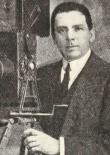'The spendthrift son of an English peer is financially embarrassed and his father sends him to Australia to make good. Before leaving for the Antipodes, the young man says goodbye to Zara, a music hall artist, with whom he has become infatuated, and a stormy scene takes place between him and the girl, who is angry at being "robbed" of what she considered to be a "desirable" husband. Keith, the young man in question, arrives on an Australian station and soon falls in love with the pretty daughter of the owner. He, however, incurs the hatred of a jealous overseer, and the latter resolves to make things uncomfortable for Keith. Zara follows the young baronet to Australia, and, by scheming, secures a position on the station as companion to Keith's sweetheart. The overseer and the actress meet and a vile plot is concocted, by which Keith and his lover become enstranged [sic]. The hero has an accident while out riding, his sweetheart goes to his assistance and they are captured by hostile blacks. The trio (including a blackboy), however, escape, and the blacks set out to destroy the homestead which they burn. In the flames Zara and the overseer meet their deaths, and virtue is triumphant and vice discomfited.'
Source:
'Electro Pictures', The Mount Barker Courier and Onkaparinga and Gumeracha Advertiser, 10 September 1915, p.4.


